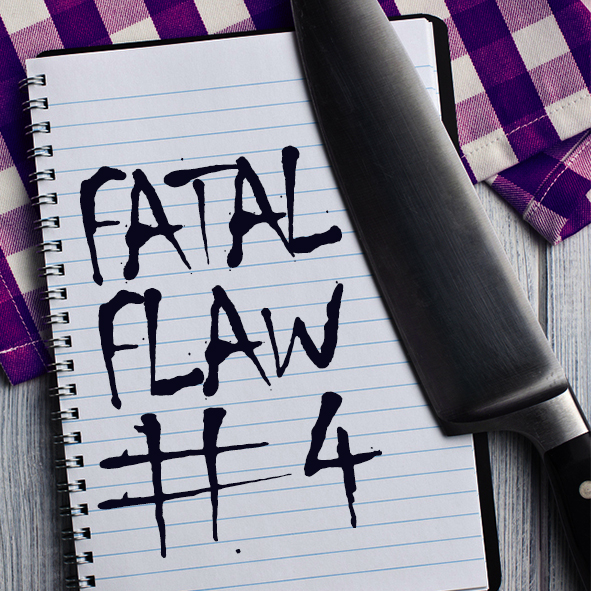Too Little Backstory Can Be a Fatal Flaw
This week wraps up our look at Fatal Flaw #4—Too Much Backstory. Writers are admonished to ditch the backstory in their opening chapters, and over the past four weeks our editors have explained why. They’ve brought to your attention all the violations of backstory dumps that writers often succumb to, for such passages bog down or stop the present action of a scene. (If you haven’t read these four very helpful posts, start with this one here.)
We’ve looked at the need to balance the important details, via dialog and narrative, so that backstory is “sprinkled in” with a few lines here and there in order to convey necessary information. This is the most effective and subtlest way to tell readers what you think they need to know, and often takes practice to get good at this technique.
The best way to get the hang of how to do this is to grab your favorite novels (preferably cheap paperback editions from a used bookstore) and a yellow highlighter pen and mark up all the lines of backstory the author includes in her scenes. Great writers will have a nice little sprinkling throughout, with maybe an occasional larger passage (a paragraph or two) when it’s needed and in just the right place.
Pay attention to these rules in particular as you study other works:
- The backstory needs to be brought out in an organic or natural-seeming way through the POV character. Instead of dumping in a few lines here or there at random from a list of key past details deemed necessary for the reader to know, a talented, experienced author will slip in these points triggered by the present action or dialog.
For example, if I need the reader to know my character was injured in the war twenty years ago, I may show him try to reach up to a high shelf to grab something, then get a stab of pain in his shoulder, which triggers his memory of how that bullet sliced through his muscle. As he rubs his shoulder, I’d have three or four lines, max, of him thinking of the past—in a way to get across all the info I need at that moment, then get right back into present action. This is a natural way our minds work, so will feel natural in your story.
- The information needs to be pertinent and important to the story. When developing ideas for a novel, authors may have pages of information about each character’s past (which is a very good thing to do before you start writing your novel). Of course, they aren’t going to use all that backstory. In fact, they may use very little.
The purpose of developing rich, detailed pasts for all main characters is to make them real. But for the most part those details inform the character’s mind-set, personality, attitudes, fears, dreams, and goals. The author needs to know all those little details, but the reader doesn’t.
So when adept writers bring out bits of backstory, they make sure every bit counts, either to reveal something about the plot, build the world, or create empathy and understanding of the character—the latter being extremely important.
- Just enough information is given to provide what’s needed in a particular scene, leaving much left unexplained. What can’t be shown through a character’s eyes during the action of a scene can be brought out in dialog, direct thoughts, or narrative (which, in either first-person or third-person POV, is still essentially coming through a character’s head)—as you’ve learned in the other posts by our editors on this topic of backstory.
Letting readers wonder, be curious for more information, is a good thing—to a point. Oftentimes, inexperienced novelists, in an attempt to leave out the backstory, do not include enough. Readers end up confused and frustrated if they don’t get some backstory, especially in the first scene or two of a novel.
This last point is something that isn’t often covered when the topic of backstory is discussed, but it’s a big problem in first novels. I think some writers have had it drilled into them that backstory is bad, and so leave it out altogether. But lack of backstory is also a fatal flaw in fiction.
So when you go through those ratty paperbacks and mark them up, pay particular attention to the amount and kind of backstory the authors introduce in the first three scenes. There may be later scenes in which a heavy bit of backstory is brought out—because the plot development at that moment requires it—but for the most part the amount of backstory will taper off considerably after those opening scenes.
Let’s take a look at the first scene in which readers are introduced to my hero in my Western romance novel Colorado Promise (written under my pen name Charlene Whitman). I’m going to give you two unconnected passages to make my point (since I wouldn’t want to unload the entire scene on you in this blog post). In the Before section, I took out all the bits of backstory I felt was needed. The After passage shows them included. See what you notice.
BEFORE:
“That’s the Wilkersons’ horse, ain’t it?” Thomas asked. “How’d it get sick?”
Lucas looked back at the boys. “You recall how I told you about horses having sensitive stomachs?” The boys nodded. “Now, a horse that gets hot and thirsty will want to take a long drink, but if it drinks a lot of cold water, it can get colicky. Or even if it spends too much time in cold water, like wading across a deep stream. Now, some folks here, coming from the East, aren’t aware how cold our Colorado rivers are. The water coming down Cache la Poudre is snowmelt—”
“And that’s really cold,” Thomas added with a twinkle in his eye showing he was pleased with his remark. . . .
“Well, boys, I need to be off. Things to tend to at the ranch.” He tipped his hat and started walking toward the graveled path that led to the street.
Thomas tugged on Lucas’s sleeve. “But when are you going to take us out to see the buffalo? You promised.”
Lucas shook his head. “Now, Thomas—”
“Tex!”
“Now, Tex, I can’t control when or where the buffalo roam. But if I catch a whiff of them anywhere around Greeley, I will come get you. So long as your folks say it’s okay.”
“They will! They will!” Thomas answered. “Hey, did you know that buffalo can jump six feet in the air? And they can run forty miles an hour!”
“Nope, didn’t know that,” Lucas said, amused at Thomas’s beaming face. “All right. Now run along.”
Lucas sighed and shook his head as the two boys ran out the stables and down the road. Ever since their father had taken them to Denver to see Bill Cody’s Wild West Show, they wouldn’t let up about wanting to see the buffalo. Well, it wouldn’t be too hard. The plains were overrun with the beasts.
Lucas hurried his pace over to the hitching rail outside the stables. His mustang opened its eyes, awaking from a lazy nap in the sun at his approach. He patted the gelding’s neck, then tightened the cinch and looped the headstall over the horse’s head.
AFTER:
“That’s the Wilkersons’ horse, ain’t it?” Thomas asked. “How’d it get sick?”
Lucas looked back at the boys. “You recall how I told you about horses having sensitive stomachs?” The boys nodded. “Now, a horse that gets hot and thirsty will want to take a long drink, but if it drinks a lot of cold water, it can get colicky. Or even if it spends too much time in cold water, like wading across a deep stream. “ He noticed the boys listening with their usual rapt attention, and a familiar pang of sadness rose up in his heart. Push that thought away, Lucas Rawlings. It will do nothing but give you heartache.
He cleared his throat, swallowing past the lump lodged there, and put on a serious face. “Now, some folks here, coming from the East, aren’t aware how cold our Colorado rivers are. The water coming down Cache la Poudre is snowmelt—”
“And that’s really cold,” Thomas added with a twinkle in his eye showing he was pleased with his remark. . . .
“Well, boys, I need to be off. Things to tend to at the ranch.” He tipped his hat and started walking toward the graveled path that led to the street.
Thomas tugged on Lucas’s sleeve. “But when are you going to take us out to see the buffalo? You promised.”
Lucas shook his head. “Now, Thomas—”
“Tex!”
“Now, Tex, I can’t control when or where the buffalo roam. But if I catch a whiff of them anywhere around Greeley, I will come get you. So long as your folks say it’s okay.”
“They will! They will!” Thomas answered. “Hey, did you know that buffalo can jump six feet in the air? And they can run forty miles an hour!”
“Nope, didn’t know that,” Lucas said, amused at Thomas’s beaming face. “All right. Now run along.”
Lucas sighed and shook his head as the two boys ran out the stables and down the road. Ever since their father had taken them to Denver to see Bill Cody’s Wild West Show, they wouldn’t let up about wanting to see the buffalo. Well, it wouldn’t be too hard. The plains were overrun with the beasts. And they were the cause of a lot of the Indian wars, Lucas reminded himself, thinking how not that long ago the Indians and white settlers had seemed to live peaceably together—until the disputes arose over the buffalo hunting grounds. Sarah had told him plenty of stories back when he’d come down from the mountains three years ago and began working for her. Her father had been a buffalo skin trader for two decades.
Three years. He’d pushed it out of his mind this morning when he woke, but the anniversary date of his arrival on the Front Range made him realize how quickly the time had passed. And how slowly the pain ebbed away. But he refused to indulge in the sadness that threatened to engulf him. He had to move forward, leave the past behind and find purpose and meaning in his life. Even though at times he wanted nothing more than to give up.
My son would have been three years old . . .
He steeled his resolve and pushed the image of Alice and the baby out of his mind. But every time he did so, a knife stabbed his heart. What hurt more than anything was how her face was fading more and more each day. All he had was the one daguerreotype they’d taken that weekend they’d gone down from Leadville to Denver. It had been Alice’s idea to pose for a picture, as she wanted to frame it and put it on the mantle. Now it sat buried under a pile of clothes in his small cabin, where he lived alone and lonely.
Sarah had recently been hinting he should think about “getting out.” Meaning, to start looking for a wife. But how could anyone ever replace Alice? No one could. He had loved her so much, and it had been his fault she’d died . . .
Stop thinking like that. You know it gets you nowhere. He’d hoped by now he’d have stopped blaming himself. He knew he’d done everything he could to save her and the baby. It was just a bad set of circumstances. The blizzard, her going into labor early, the doctor sick, not able to clear the snow and get any help. He’d tried everything. God knows he’d tried.
Lucas hurried his pace over to the hitching rail outside the stables. His mustang opened its eyes, awaking from a lazy nap in the sun at his approach. He patted the gelding’s neck, then tightened the cinch and looped the headstall over the horse’s head.
What did you notice about the second passage? All the backstory brought into that introductory scene is important to setting up just who Lucas Rawlings is and how his past pain has shaped him.
Get Readers to Care by Bringing in Backstory
The most critical thing a novelist needs to do when introducing a character is to hint at his core need, what past events have shaped and affected him, what his greatest fear is, and/or what his deepest desire is.
It’s a writer’s job to get readers to quickly care and empathize with the protagonist (and sometimes other main characters), and one of the best ways to do this is to bring in those bits of backstory in a natural way, right away, in the opening scene with that character (which may not be the first scene in your book).
So take some time to study the way great writers sprinkle in the backstory. Don’t make the mistake of leaving it out altogether—that’s just as much a fatal flaw of fiction writing as is too much backstory. Then practice this technique in your own scenes until you get it down pat.
Your turn:
Share a passage from a novel you love that shows backstory sprinkled in effectively. What are your thoughts on how much backstory is enough or too much? Have you read opening scenes in novels in which there just isn’t enough backstory to help you follow the story?









Guilty as charged! I not only got rid of all flashback scenes in my novel (probably a good thing), but also almost all tidbits of backstory (definitely a bad thing). Now I’m trying to add in just the right amount.
This topic has been very helpful for me as I work on my rewrite!
Thank you, thank you, thank you. I loved this post and the conclusion that there is such a thing as too little back story.
Too many times, writers get caught in the trap of thinking that if a little bit of something is good for their novels, then none of it is even better. I have been caught in that trap myself and know it’s difficult to escape.
But nothing could be further from the truth and your example pointed that out to perfection.
Writers need to take the time to think about their stories and their characters, determine what is needed for each, and figure out the best way to write it because no two stories or characters are the same. That applies to all aspects of craft, not just back story.
My thanks to you again for an edifying post!
Carrie
It sounds so easy! Just have to laugh. In a rewrite myself, and I am constantly fighting myself with how much is too much or not enough. Thanks for the reminder that we all struggle with backstory.
It isn’t easy at all, learning how to get just the right balance. Following Linda’s rule of three helps a lot. But overall, you want just enough at first to start painting a picture for the purpose of revealing motivation. Later you can add more details, if it helps the story. But if you keep in mind that the objective in the opening scenes is to generate empathy for your protagonist and understand each character’s motivation, that should help you decide what bits of backstory to include.
Thank you for this post, and I must go back and read the others. I’m so guilty of the backstory bog. I did purchase and read your Colorado Promise and I don’t recall seeing much backstory, or if I did, it only brought out the love for the character. The WIP that’s beating me to death right now opens with a woman who just lost everything and she’s walking away to try and start a new life. It has me pulling my hair out. I suppose I’ll get it right someday, but it sure is hard to kill our darling words.
Thanks, Connie. As I mentioned, the key to backstory is to put in just enough to make clear the character’s motivation and emotional state. Dropping bits in as you play out the story is the most effective. Of course, getting a critique of your first chapters will really help you see just what needs to be done or added to make it gripping.
I’d like to know what you think about this…When a person is alone, either before or after encountering another, he might stay in a reflective mode and spend a fair amount of time ruminating on pieces of the past that are relevant to what has happened or is about to. Of course, in a story one must avoid letting those reflective moments go on too long. They could create too long a gap in the forward movement of real time and lessen its tension. But it seems to me that, done properly, a relatively lengthy period of reflection – perhaps a few modestly sized paragraphs – can hint at past events (both from before real time and earlier in real time) can add tension. I enjoy novels that have longer reflective passages so long as they are indeed the character “speaking” and not the author intruding. Sometimes I think that modern readers have shortened attention spans that cause inexperienced writers to ignore the value of backstory and shorten them more than is necessary.
Your advice is so good. I’d love to know what you think.
Jim
Hi Jim. When a character is in “reflection mode,” he’s going to think a bit more about his past and it’s a great place to bring in backstory. However, you want to watch against having characters just sitting around thinking and doing nothing else for pages. I always try to have these reflective moments going on while the character is busy doing something significant. It might be work-related, or doing chores that need to be done. It’s so important to show character motivation and mind-set, and a huge part of the character arc takes place as he processes the things that are happening to him (in the story) and his views, feelings, beliefs, and/or types of choices change. All this is due to reflection/reaction to things that have happened. I learned that everything is action/reaction. Every time something happens in a scene, the character has to react. Then at some point, now or later, briefly or extensively, that reaction needs to be reflected upon. It’s all very natural and how we humans function.
Thanks for the insightful comment.
Thanks for nailing it down for me: everything is action and reaction. Those three words might become a mantra for me, reminding me of the importance of making a characters reflections relevant and not letting them go on too long. Balance!
Jim